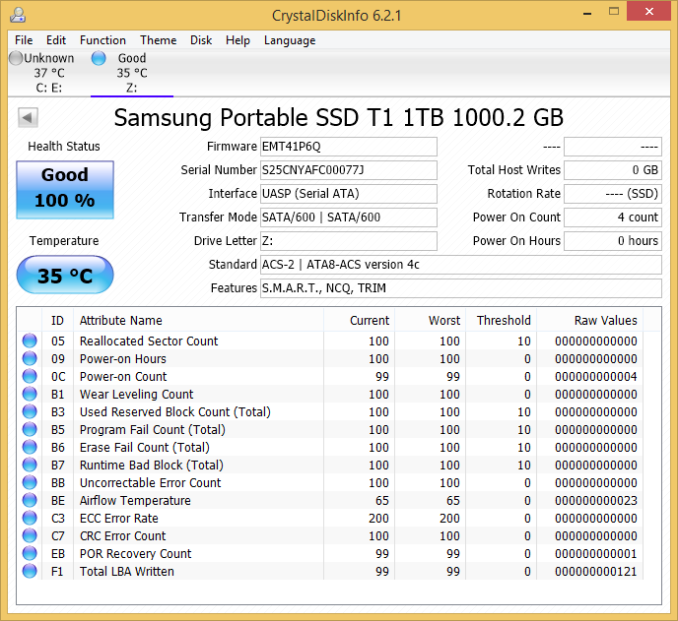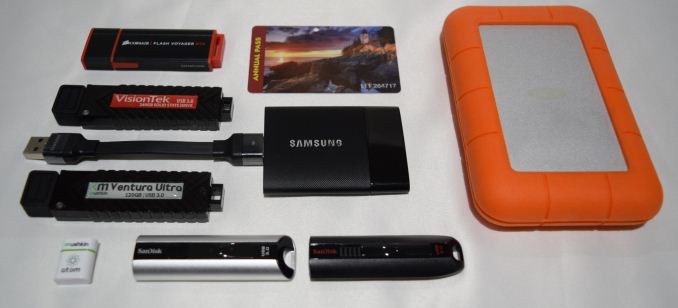Samsung Portable SSD T1 Review
by Ganesh T S on January 20, 2015 10:00 AM EST
Introduction and Testing Methodology
The last few years have seen rapid advancements in flash technology and the rise of USB 3.0 as an ubiquitous high-speed interface on computers. These have led to the appearance of small and affordable direct attached storage units with very high performance for day-to-day data transfer applications. We have already looked at some flash drives with SSD controllers and a USB 3.0 - SATA bridge over the last couple of months. These include the Corsair Flash Voyager GTX 256GB using the Phison S9 controller and the Mushkin Ventura Ultra using the SandForce SF2281 controller respectively.
At CES 2015, Samsung introduced the Portable SSD T1. With the introduction of the T1, Samsung becomes the first tier one manufacturer to enter the external SSD market (if you discount SanDisk's Extreme PRO USB 3.0 flash drives, which, despite being a SSD behind a USB 3.0 - SATA bridge, was never advertised as one). Hardware wise the T1 is based on the 850 EVO, meaning that the T1 uses 32-layer TLC V-NAND and the same full-fledged MEX/MGX SSD controller. CrystalDiskInfo gives us further insight into the unit.
Even though CrystalDiskInfo reports TRIM as a feature, we were unable to get it to work through the bridge configuration. In any case, Samsung also doesn't make any claims about TRIM support. S.M.A.R.T data was not visible to most of the commonly used tools. On the USB 3.0 side, the drive supports UASP (USB-attached SCSI Protocol) that should provide increased performance for sequential transfers. Claimed transfer rates are 450 MBps for sequential accesses and 8K read IOPS / 21K write IOPS. We also have hardware-accelerated AES-256 encryption.
Our review unit was pre-formatted in exFAT. Upon connecting to our testbed, a 128 MB FAT32 partition popped up and provided directions for installing the software / service that allows for the drive to be monitored / utilized with encryption capabilities. After installation, the 128 MB partition disappeared, and the 1 TB volume was made visible. The Samsung SSD program / daemon continues to run in the background and allows for altering the security option (encryption) without reformatting the partition. The gallery below shows the UI of the software running on Windows 8.1 Pro.
Testbed Setup and Testing Methodology
Evaluation of DAS units on Windows is done with the testbed outlined in the table below. For devices with USB 3.0 connections (such as the Samsung Portable SSD T1 that we are considering today), we utilize the USB 3.0 port directly hanging off the PCH.
| AnandTech DAS Testbed Configuration | |
| Motherboard | Asus Z97-PRO Wi-Fi ac ATX |
| CPU | Intel Core i7-4790 |
| Memory | Corsair Vengeance Pro CMY32GX3M4A2133C11 32 GB (4x 8GB) DDR3-2133 @ 11-11-11-27 |
| OS Drive | Seagate 600 Pro 400 GB |
| Optical Drive | Asus BW-16D1HT 16x Blu-ray Write (w/ M-Disc Support) |
| Add-on Card | Asus Thunderbolt EX II |
| Chassis | Corsair Air 540 |
| PSU | Corsair AX760i 760 W |
| OS | Windows 8.1 Pro |
| Thanks to Asus and Corsair for the build components | |
The full details of the reasoning behind choosing the above build components can be found here.
Samsung Portable SSD T1 - Size Comparison (standard credit card size also pictured for a frame of reference)
The list of DAS units used for comparison purposes is provided below.
- Samsung Portable SSD T1 1TB
- Corsair Voyager GTX 256GB
- LaCie Rugged Thunderbolt 500GB
- Mushkin Atom 64GB
- Mushkin Ventura Ultra 120GB
- SanDisk Extreme 64GB
- SanDisk Extreme PRO 128GB
- VisionTek Pocket SSD 240GB


















68 Comments
View All Comments
haukionkannel - Tuesday, January 20, 2015 - link
It would be very nice to see a comparison of external USB3 storage and different SSD disks to see if there is difference how well SSD will work without trim and is there is difference between controllers etc. It would be also nice to have an article for "dummies" how over provisioning affect in this kind of situation. I am also quite sure that not everyone knows how to change over provisioning with their SSD drives and how does it affect to ssd behavior.As it has been said you can get good quality USB3 enclosure and ssd for much less than there ready made versions. Comparison would be nice!
neillanz - Tuesday, January 20, 2015 - link
What I wonder about the most is if Samsung took care of unexpected power loss problem and if so, then how. The problem I always have while using an SSD with a SATA to USB bridge is that every time I disconnect it, the unexpected power loss count rises. Perhaps know with the UASP, it's possible to send a shutdown command to the drive itself.Laststop311 - Wednesday, January 21, 2015 - link
thats what the little icon in the tray is for. You right click it and select eject usb drive and then a bubble pops up and says it is now safe to disconnect your usb drive. You really didn't know that?neillanz - Wednesday, January 21, 2015 - link
Of course I know about the the Safe Removal option, but so far it never helped when unplugging an SSD. No matter what the unexpected power loss count would grow.digiguy - Tuesday, January 20, 2015 - link
I don't think this drive offers the same comfort of the GTX 256 or Sandisk extreme (I own both) on a very portable device, such as my Surface pro 3 or small ultrabooks. I wouldn't trust moving around with the device and this thing hanging. Also it would be interesting to know how much power this drive drains. According to my tests, the 2 pen drives I mentioned take very little power, while a 2.5" SSD in a USB 3.0 enclosure (I have several of both) takes much more power, much closer to a HDD. I have used a power meter, but even without that I can see that for instance with the Surface I can write between the 2 pen drives in an unpowered hub, and still have a mouse and something else attached, but I generally cannot do it between an external SSD and a pen (sometimes it works but the speed goes down), let alone 2 external SSDs. I have tested several unpowered hub, which themselves take some power, some more than others... Hopefully there will be some testing of the power consumption.Laststop311 - Wednesday, January 21, 2015 - link
You have to normalize the power consumption for the greater performance. Meaning since its faster it finishes the transfer faster and goes back into idle faster. So you need to take into account the amount of power used from transfer start to transfer finish. The other drives may use less power but they are transferring for a longer amount of time and that can easily bring its amount of battery power used close to equal.digiguy - Wednesday, January 21, 2015 - link
Normalize the power consumption for greater performance? I suppose you are comparing an external SSD with the pen drive I mentioned, as SSDs are actually much faster than HHD while consuming less.... As for pen vs SSD, considering the GTX, if we talk about read speed, they are pretty close.... I have several SSDs, among them Crucial MX100, Sandisk Extreme pro and the GTX is close and goes up to the limit of the USB 3.0 bandwith. In terms of write spead, there is a clear gap, but it's well known that write speed and the size of a pen drive don't go well together. Still, compared to "standard" USB 3.0 pen drives, these 2 I mentioned are amazing. The point I was making however was not about battery life, but about the capacity of a small laptop/ultrabook/convertible (as these drives are meant to be used mainly on the go) to power these drives, including moving data directly from one to the other. With the pen drives (even the fastest) you can do that, as their power consumption is a fraction of even that of an external SSD, let alone an HDD. So this is one of the strengths of such drives.sonicmerlin - Tuesday, January 20, 2015 - link
Augh I want someone to release a 20 nm V-NAND SSD that blows away the HDD market's $/GB values. When will this happen?Laststop311 - Wednesday, January 21, 2015 - link
Then you lose the benefits of 40nm which are numerous. Also while you can fit more nand dies per wafer with 20nm the process of making each wafer of dies is more expensive so if the increased amount of dies doesn't offset or better the increased cost of 20nm then it's actually cheaper for them to be at 40nm. You also have to take account of defect rates. If the defect rates of 20nm are a certain percentage higher than 40nm that also makes it hard for the increased amount of dies on 20nm to be enough of a bonus to make it cheaper.AJSB - Wednesday, January 21, 2015 - link
Please NO !20nm will bring back more problems than benefits, if i ever considered a SSD is precisely the 850 EVO because the type of NAND and be 40nm.
What happens now is that Samsung is charging a premium for be the only ones with this type of NAND, AFAIK.
When there will be more players doing it, prices will fall, not to mention that this type of NAND is still in the begin of production...as Samsung increases production, prices will possibly decrease with or without more OEMs doing this type of NAND.